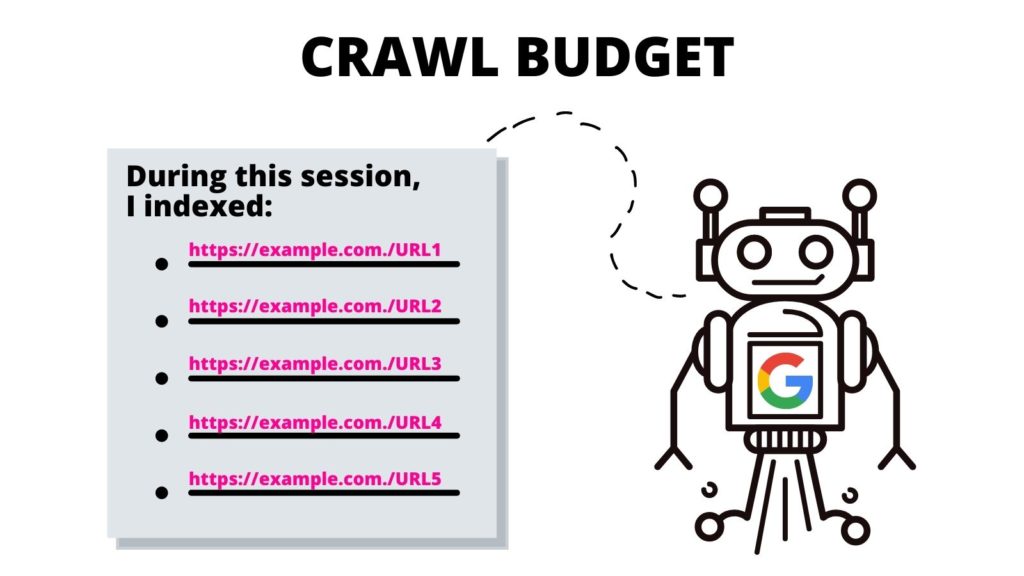Unraveling the mystery of crawl budget: How search engines determine which pages to crawl first and how it impacts SEO.

Image courtesy of via DALL-E 3
Table of Contents
Welcome to our guide on understanding the concept of crawl budget and why it’s crucial for websites like yours. In simple terms, crawl budget refers to the number of pages a search engine, such as Google, crawls and indexes from your site within a specific timeframe. It plays a significant role in determining how visible your website is on search engines, impacting its overall performance and ranking.
What is a Crawl Budget?
Before we delve deeper into why crawl budget matters, let’s discuss what it actually means. Imagine your website as a book, and search engines as readers looking for information. Just like readers can only read a certain number of pages in a day, search engines have a limited capacity to crawl and index pages on your site. This capacity is what we refer to as your crawl budget.
Why Should We Care?
Understanding and managing your crawl budget is essential for website owners because it directly affects how well your site performs on search engines. If search engines can’t crawl and index your pages effectively, your content may not show up in search results, making it harder for potential visitors to find you. By optimizing your crawl budget, you can ensure that your website is efficiently crawled and indexed, improving its visibility and search engine ranking.
How Search Engines Work
What is Crawling?
Search engines like Google have a big job. They need to find all the pages on the internet so that when you search for something, they can show you the most relevant results. This process is called crawling.
Imagine a search engine as a super-fast robot that goes from one website to another, following links to discover new pages. It reads the content on each page and collects information to understand what the page is about.
What is Indexing?
Once the search engine robot crawls a page, it stores the information it found in a huge database. This database is called an index. It’s like a giant library where all the information from crawled pages is organized and stored.
When you search for something on Google, it looks through this index to find the most relevant pages that match your query.
What is Included in a Crawl Budget?
One essential component of a crawl budget is the crawl rate limit. This refers to the speed at which search engines like Google make requests to your website to crawl its pages. Search engines set limits on the number of requests to prevent overwhelming a site’s server and ensure fair crawling for all websites.
Crawl Demand
Another crucial factor in determining a crawl budget is crawl demand. This concept focuses on how search engines prioritize crawling based on the popularity and freshness of a page. Popular or frequently updated pages are more likely to be crawled more often and more deeply, consuming a larger portion of the crawl budget.
How to Make the Most of Your Crawl Budget
When it comes to optimizing your crawl budget, it’s crucial to identify and prioritize the most important pages on your website. These might include frequently updated content, high-traffic pages, or product pages that drive revenue. By focusing on these key pages, you can ensure that search engines crawl and index them more frequently. This can help improve your site’s visibility and organic traffic.

Image courtesy of traffv.com via Google Images
Improve URL Structure
Having a clean and organized URL structure is essential for making the most of your crawl budget. Search engines use URLs to navigate and understand the content of your site. By structuring your URLs in a logical and hierarchical manner, you can make it easier for search engine crawlers to discover and index your pages efficiently. Avoid long, confusing URLs with unnecessary parameters, and use descriptive keywords to help search engines understand the context of each page.
Tools to Monitor Crawl Budget
When it comes to managing your website’s crawl budget, it’s essential to have the right tools at your disposal. Monitoring your crawl budget can help you track how search engines interact with your site and make informed decisions to improve its visibility. Let’s explore some of the tools you can use to monitor and manage your crawl budget effectively.
Using Google Search Console
Google Search Console is a free tool provided by Google that allows website owners to monitor how their site is performing in Google search results. By verifying your site with Google Search Console, you can access valuable insights into your crawl budget.
Within Google Search Console, you can view the number of pages crawled per day, any errors encountered during the crawling process, and which pages are being indexed. By analyzing this data, you can identify any issues that may be impacting your crawl budget and take steps to address them.
Other Useful Tools
In addition to Google Search Console, there are several other tools available that can help you monitor and optimize your website’s crawl budget.
Tools such as Screaming Frog, DeepCrawl, and Sitebulb provide detailed insights into how search engines crawl and index your site. These tools can help you identify issues like broken links, duplicate content, and crawl errors that may be affecting your crawl budget.
Furthermore, tools like SEMrush and Moz offer comprehensive site audits that can help you track your site’s performance and identify opportunities for improvement. By leveraging these tools, you can gain a deeper understanding of your crawl budget and make data-driven decisions to enhance your website’s visibility in search engine results.
Common Issues That Affect Crawl Budget
Broken links, also known as 404 errors, can have a significant impact on your site’s crawl budget. When search engine bots encounter broken links while crawling your website, they waste valuable resources that could have been used to discover and index other important pages. To prevent this issue, regularly check your site for broken links and fix them promptly. You can use online tools to scan your website for broken links and ensure a smooth crawling experience for search engine bots.

Image courtesy of www.linkgraph.com via Google Images
Duplicate Content
Duplicate content refers to identical or very similar content that appears on multiple pages within your website. Having duplicate content can confuse search engine bots and lead to inefficient crawling, as they may focus on crawling the same content multiple times instead of discovering new and valuable information. To avoid this issue, ensure that each page on your site offers unique and relevant content. You can use canonical tags to specify the preferred version of a page in case of duplicate content, effectively consolidating crawling efforts towards the correct page.
Advanced Tips for Managing Crawl Budget
In this section, we will delve into more advanced strategies for managing your crawl budget efficiently. By implementing these tips, website owners can further optimize their site’s performance on search engines.
Using Robots.txt
One advanced technique for managing crawl budget is utilizing a robots.txt file. This file acts as a set of instructions for search engine crawlers, guiding them on which pages to crawl and which to ignore. By specifying certain areas of your site to be excluded from crawling, you can direct the crawl budget towards more critical pages.
Creating an XML Sitemap
An XML sitemap is a valuable tool that helps search engines navigate your site’s structure more effectively. By creating and submitting an XML sitemap, you provide search engines with a roadmap of important pages on your site, enabling them to prioritize crawling these pages. This can result in better indexation and visibility for key content.
Using Noindex Tags
Noindex tags are HTML meta tags that instruct search engines not to index specific pages. By strategically implementing these tags on pages that do not need to be indexed, you can conserve crawl budget for pages that are more valuable to your site. This can help improve the overall efficiency of how search engines crawl and index your content.
Conclusion
In conclusion, understanding and managing your website’s crawl budget is crucial for ensuring optimal visibility on search engines like Google. By following the tips and strategies outlined in this article, website owners can maximize their crawl budget to ensure that important pages are crawled and indexed efficiently.

Image courtesy of www.digitalwebsolutions.com via Google Images
Key Takeaways
To recap, here are the key takeaways from each section:
- What is a Crawl Budget?: The crawl budget refers to the number of pages a search engine crawls and indexes from your site within a given timeframe.
- How Search Engines Work: Search engines like Google use crawling and indexing processes to discover and organize information on websites.
- What is Included in a Crawl Budget?: Factors such as crawl rate, crawl demand, and URLs determine the extent to which search engines crawl your site.
- How to Make the Most of Your Crawl Budget: Prioritizing important pages and improving URL structure can help optimize your crawl budget.
- Tools to Monitor Crawl Budget: Google Search Console and other tools can help you track and manage your site’s crawl budget.
- Common Issues That Affect Crawl Budget: Broken links and duplicate content can hinder your crawl budget, so it’s essential to address these issues promptly.
- Advanced Tips for Managing Crawl Budget: Utilizing robots.txt, XML sitemaps, and noindex tags can help you control how search engines crawl and index your site.
By incorporating these insights into your website management strategy, you can enhance your site’s visibility and overall performance in search engine results pages.
Want to turn these SEO insights into real results? Seorocket is an all-in-one AI SEO solution that uses the power of AI to analyze your competition and craft high-ranking content.
Seorocket offers a suite of powerful tools, including a Keyword Researcher to find the most profitable keywords, an AI Writer to generate unique and Google-friendly content, and an Automatic Publisher to schedule and publish your content directly to your website. Plus, you’ll get real-time performance tracking so you can see exactly what’s working and make adjustments as needed.
Stop just reading about SEO – take action with Seorocket and skyrocket your search rankings today. Sign up for a free trial and see the difference Seorocket can make for your website!
Frequently Asked Questions (FAQs)
What Happens If I Exceed My Crawl Budget?
Exceeding your crawl budget can have negative consequences for your website’s performance on search engines. If search engines like Google crawl too many pages on your site or spend too much time crawling inefficiently, they may miss important updates or new content. This could result in your latest information not being indexed promptly, leading to lower visibility in search results. To avoid exceeding your crawl budget, focus on optimizing your site’s structure and content to ensure search engines can efficiently crawl and index your pages.
How Can I Increase My Crawl Budget?
To potentially increase your crawl budget, you can implement various optimization techniques on your website. One effective strategy is to enhance your site’s speed and performance, as faster-loading pages are more likely to be crawled and indexed promptly. Additionally, organizing your site’s internal linking structure and focusing on creating high-quality, unique content can help attract search engine crawlers to explore more of your site. Regularly monitoring and resolving any crawl errors, such as broken links or duplicate content, can also improve your crawl budget over time.







